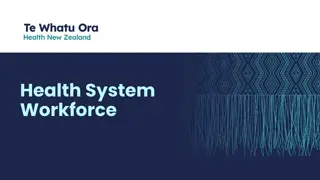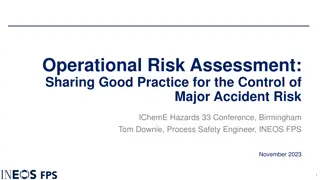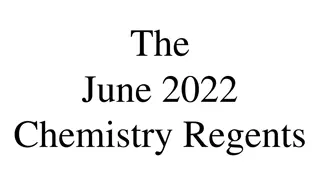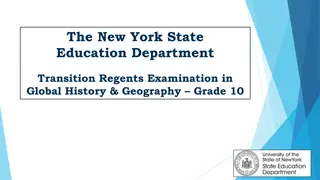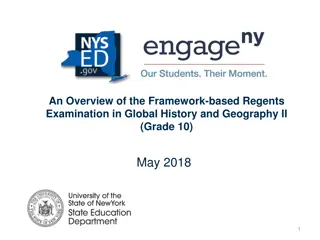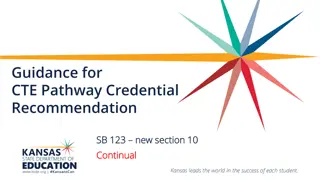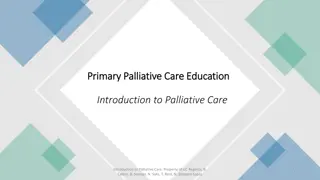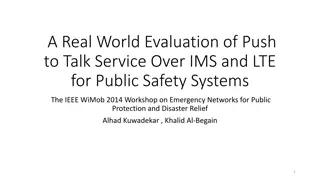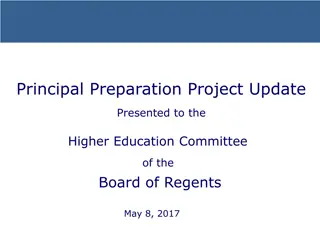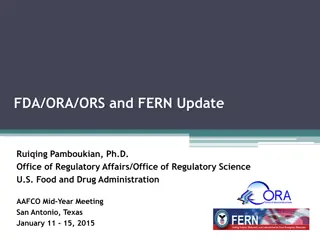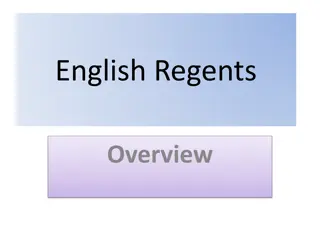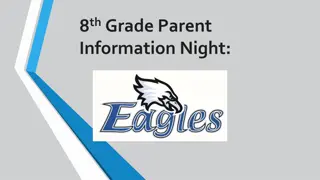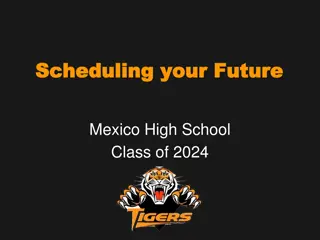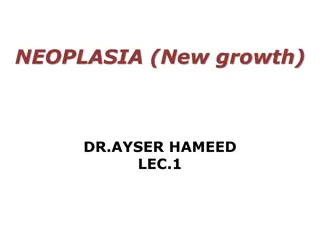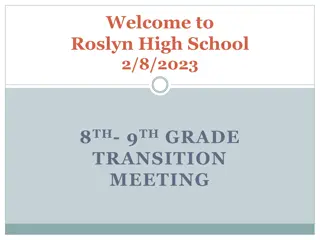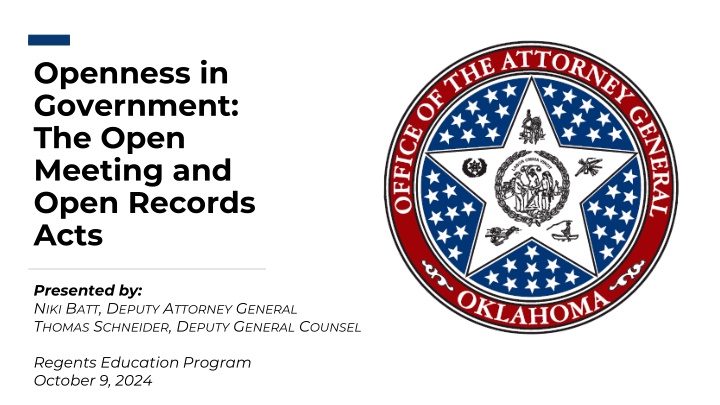
Openness in Government: The Open Meeting and Open Records Acts
Explore the key aspects of the Open Meeting Act and Open Records Act presented by Niki Batt and Thomas Schneider. Learn about recent changes, the public purpose of the OMA, when it applies, definitions of a public body, elements of public body analysis, and exempt public entities.
Download Presentation

Please find below an Image/Link to download the presentation.
The content on the website is provided AS IS for your information and personal use only. It may not be sold, licensed, or shared on other websites without obtaining consent from the author. If you encounter any issues during the download, it is possible that the publisher has removed the file from their server.
You are allowed to download the files provided on this website for personal or commercial use, subject to the condition that they are used lawfully. All files are the property of their respective owners.
The content on the website is provided AS IS for your information and personal use only. It may not be sold, licensed, or shared on other websites without obtaining consent from the author.
E N D
Presentation Transcript
Openness in Government: The Open Meeting and Open Records Acts Presented by: NIKI BATT, DEPUTY ATTORNEY GENERAL THOMAS SCHNEIDER, DEPUTY GENERAL COUNSEL Regents Education Program October 9, 2024
The Open Meeting Act (OMA) 25 O.S.Supp.2024, 301 314 Yellow Book (2024) Page 1
WHAT HAS CHANGED? 2024 OK AG 12; House Bill 3780, 2024 Okla. Sess. Laws ch. 246, 1 2 (amending section 307.1 and NEW section 311.1); House Bill 1382, 2024 Okla. Sess. Laws ch. 237, 3 (amending Section 304); Senate Bill 1716, 2024 Okla. Sess. Laws ch. 44, 1 (amending Section 307); Senate Bill 1933, 2024 Okla. Sess. Laws ch. 180, 3 (amending Section 307); and House Bill 3937, 2024 Okla. Sess. Laws ch. 60, 1 (amending Section 311);
PUBLIC PURPOSE OF OMA Encouraging citizens to know more about public bodies, governmental processes, and governmental problems (advance notice, agenda, and minutes). Creating space for citizens to come and watch government in action as the public body tackles the issues of the day (open meetings to the public at convenient times and places). 25 O.S. 2021, 302, Yellow Book 1.
WHEN THE OMA APPLIES? When a majority of a public body s members come together to conduct public business. 25 O.S. 2021, 304(2), Yellow Book 3.
PUBLIC BODY DEFINED 25 O.S. 2021, 304(1), Yellow Book 2. Municipal governing bodies Boards of county commissioners Boards of public and higher education All authorities, councils, committees, and public trusts boards, bureaus, commissions, agencies, trusteeships, Any committee or subcommittee of a public body
ELEMENTS OF PUBLIC BODY ANALYSIS Supported by public funds (full or partial) Entrusted with spending public funds Administration of public property Actual or de-facto decision-making authority*
EXEMPT PUBLIC ENTITIES The Judiciary State Legislature and legislators Administrative staff of public bodies Other entities, incl. Racing Stewards, Council on Judicial Complaints Multi-disciplinary teams provided for under Title 10A of the Oklahoma Statutes for sole purpose of considering recommendations of team and deciding placement of a child Board of Directors of federally-qualified health center Committees that are purely fact finding, informational, recommendatory, or advisory with no decision-making authority. Andrews v. Indep. Sch. Dist. No. 29 of Cleveland Cnty., 1987 OK 40, 737 P.2d 929.* Private organizations that contract to provide goods or services to the public on behalf of a governmental agency and receive payment as reimbursement. 2002 OK AG 37. Post adjudication review boards authorized in title 10 of the Oklahoma Statutes.
MEETING DEFINED Conduct of business of a public body by a majority of its members being personally together or, as authorized by Section 307.1 of this title, together pursuant to a videoconference. Meeting shall not include informal gatherings of a majority of the members of a public body when no business of the public body is discussed. 25 O.S.2021, 304(2), Yellow Book 3.
MAJORITY vs. QUORUM OMA default for quorum is a majority. Specific act or rule may determine that less than a majority of the public body is authorized to transact business on behalf of the public body. In any event, rely on the specific statute or rule over 304(2) when determining if a meeting must comply with the OMA. Unpublished Opinion 93-587. EXAMPLE: X members shall be authorized to transact business for the [Public body]. Ex-officio members can (and should) be included in your count if not expressly excluded. See 2009 OK AG 26. Your quorum DOES NOT decrease in light of a vacancy. See 1982 OK AG 165.
CONDUCTING PUBLIC BUSINESS Includes the entire decision-making process, including presentation deliberation, decision, or formal action. of information, In re Appeal of Order Declaring Annexation Dated June 28, 1978, 1981 OK CIV APP 57, 637 P.2d 1270; 1982 OK AG 212.
MEETINGS OF LESS THAN A QUORUM 2020 OK AG 4 Rep. Walke asked whether a minority of a public body members can meet outside of a public meeting consistent with the OMA. The short answer is that it depends. If the public body is doing so to willfully and purposefully circumvent the Act, a court might say that such a meeting, even among a minority, is a violation. DO NOT Conduct polling, or Hold discussions with the desired aim of reaching a consensus prior to a meeting. Allowed to hold informational briefings where information is provided and received. REMEMBER: The purpose of the OMA is to facilitate public knowledge and awareness of governmental problems and processes.
CIRCUMVENTING THE ACT Public body cannot use informal gatherings or telephonic among a majority members to decide any action or vote on any matter. Convenient Legal. electronic communications of or the 25 O.S. 2021, 306, Yellow Book 5.
OMA FLOWCHART
MEETINGS MEETINGS
CORE REQUIREMENTS Provide Advance Notice Post Agenda
ADVANCE NOTICE TO WHOM? State public bodies and governing boards of higher education: Secretary of State. County public bodies, boards of education, and public bodies under the auspices of a governing board of higher education: County Clerk of the county in which the body is principally located. Municipal public bodies: Municipal Clerk. 25 O.S. 2021, 311(A)(2-7), Yellow Book 14.
TIMES AND PLACES OF MEETINGS SPECIFIED times and places, CONVENIENT to the public, OPEN to the public, and Must provide advance notice (agenda). 25 O.S. 2021, 303, Yellow Book 1.
Rogers v. Excise Bd. of Greer Cnty. 1984 OK 95, 701 P.2d 754 Excise Bd. scheduled meeting to be held on a legal holiday. The meeting location was held in a locked courthouse. The court held that this was a willful violation of the OMA. The Excise Board demonstrated a blatant or deliberate disregard by those who know or should know, if not a willful and purposeful violation of the OMA.
TYPES OF MEETINGS REGULARLY SCHEDULED MEETINGS SPECIAL MEETINGS EMERGENCY MEETINGS CONTINUED OR RECONVENED MEETINGS
REGULARLY SCHEDULED MEETINGS Advance Notice All meetings for the upcoming calendar year must be sent to the appropriate record-keeping clerk by December 15 of the current year. Time, date, and place. Posting the Agenda 24 hours prior to the time of the meeting in prominent public view at location of meeting or the principal office of public body, AND May also upload to public body s website.* Excludes Saturdays, Sundays, and public (legal) holidays. New business allowed to the extent that it meets the following: If it is known about or could have reasonably been foreseen prior to the time of posting the notice and agenda for the meeting, then it is not new business. See 25 O.S. 2021, 311(A)(10). 25 O.S. 2021, 304(3) & 311(A)(1, 8 10), Yellow Book 3 & 14 16.
REGULARLY SCHEDULED MEETINGS (contd) Changing the date, time, or place? Notice must be given to the appropriate recordkeeping clerk no less than ten (10) days prior to the implementation of any such change. What does this mean? A public body cannot change the time, date, or place of a regularly scheduled meeting if the meeting is set less than ten (10) days away. A public body maymove up a regularly scheduled meeting, but the meeting cannot be scheduled less than ten (10) days from the date that notice of the change is published. BEST PRACTICE: Set a special meeting if the issue(s) is/are urgent and cancel the regularly scheduled meeting.
SPECIAL MEETINGS Advance Notice 48 hours prior to time of meeting. Time, date, and place. Must also send notice to those who have requested to receive notice of meeting. Posting the Agenda 24 hours prior to the time of the meeting in prominent public view at location of meeting or the principal office of public body, or Public Body may elect the agendas for special meetings to its website. Excludes Saturdays, Sundays, and public (legal) holidays. New business NOT permitted. 25 O.S. 2021, 303(4) & 311(A)(12), Yellow Book 3 & 16 17.
EMERGENCY MEETINGS Must first meet the definition of emergency , which is a situation involving injury to persons or injury and damage to public or personal property or immediate financial loss when the time requirements for public notice of a special meeting would make such procedure impractical and increase the likelihood of injury or damage or immediate financial loss. Advance Notice As much advance notice as is reasonable and possible under the circumstances existing, and In person, telephonic, or electronic. Posting the Agenda As much advance notice as is reasonable and possible under the circumstances existing. Must include nature of emergency and reasons for declaring such emergency meeting in written minutes for an emergency meeting. 25 O.S. 304(5) and 311(A)(13), Yellow Book 4 & 17.
CONTINUED OR RECONVENED MEETINGS Give notice of such action that the original meeting, including Date, Time, and Place of continued meeting. Only matters appearing on the agenda for the meeting continued may be discussed on continuance or reconvening meeting. BEST practice: Post notice on website and with recordkeeping clerk. Also, post updated agenda with remaining items of business. 25 O.S. 2021, 304(6) & 311(A)(11), Yellow Book 4 & 16.
VIDEOCONFERENCE & TELECONFERENCE 1. Not less than a quorum must be present at site of meeting. 2. All public body members must be audible and visible to one another. 3. Executive sessions are NOT allowed. 4. Notice and agenda must include the locations of the meeting; the videoconference sites (i.e., location, address, and telephone number); and identity of members and from where they will appear. 5. Members of public bodies may only participate from the district or subdivision from which they are elected, appointed, or sworn to represent. 6. Materials shared must be immediately available in the same form and manner as shared with the public body. 7. Public must be allowed to participate and speak as allowed by rule or policy set by the public body at the videoconference site as permitted at the site of the meeting. 8. Each site and room must be open and accessible to the public. 25 O.S. 2021, 307.1, Yellow Book 11 13.
MINUTES & RECORDING Must be written and taken by a designated person. Minutes are an official summary of the proceedings Must show who is present and absent, matters considered, and actions taken (2012 OK AG 24); Shall be open for inspection, and Shall reflect the manner and time of notice required under the OMA. Minutes must be taken in executive session. Berry v. Bd. of Governors of Registered Dentists, 1980 OK 45, 611 P.2d 628. State law does not require minutes to be approved. Recording the proceedings Members of the public can record the meeting; however, they are not entitled to interfere with the conduct of the public meeting. 25 O.S. 2021, 312, Yellow Book 19 20.
PUBLIC COMMENTS Public bodies are not required to allow an opportunity for the public to comment on matters or issues being considered by the public body, but it may allow for such comments. Public bodies may limit public comment to items set forth on the agenda, or it may allow for open comment. If a public body decides to include public comment in its meetings, the public body should consider adopting a policy, such as setting a time limit for each person providing public comments, setting a cut-off for when persons must sign up to participate in the public comments, and potentially limiting the comments to agenda items. 2022 OK AG 26; 1998 OK AG 45.
PUBLIC COMMENTS (contd) An agenda item titled VisitorsComments or PublicComments is sufficient to meet the requirements under the OMA. CAUTION: Items for discussion on the agenda should not be discussed by the public body at this time. This is the public body s opportunity to listen.AG 45. 2022 OK AG 26; 1998 OK AG 45.
TAKING ACTION Votes of each member of a public body: must be publicly cast and recorded. May only take action on agenda items that indicate or provide for action to be taken. If the vote is either not publicly cast or not recorded, the action taken is invalid. Oldham v. Drummond Bd. of Educ., 1975 OK 147, 542 P.2d 1309. 25 O.S. 2021, 305, Yellow Book 4.
AGENDAS AGENDAS
WORDING THE AGENDA Shall identify all items of business to be transacted by a public body at a meeting. Must include any proposed executive session If executive session is proposed, public body must: Contain sufficient information for public to know what the public body is going to discuss. Identify items of business and purposes of executive session, and State which provision under 307 applies. 25 O.S. 2021, 311(B), Yellow Book 18.
WORDING THE AGENDA (contd) Must be worded in plain language, directly stating the purpose of the meeting. Language used should be Simple, Direct, and Comprehensible to a person of ordinary education and intelligence. Andrews v. Indep. Sch. Dist. No. 29 of Cleveland Cnty., 1987 OK 40, 737 P.2d 929; Haworth Bd. of Educ. Of Indep. Sch. Dist. No. I-6, McCurtain Cnty. v. Havens, 1981 OK CIV APP 56, 637 P.2d 902.
WORKING THROUGH THE AGENDA Nothing in the Act requires you to follow the agenda item by item. Nothing in the Act requires you to take up all items on the agenda. But the Act does prohibit you from taking action not noticed on the agenda. Example: The [public body] may take up items in any order it deems necessary and convenient.
AGENDA EXAMPLE #1 Wilson v. City of Tecumseh, 2008 OK CIV APP 84, 194 P.3d 140 Public body publishes the following agenda item for a proposed executive session, Proposed Executive Session pursuant to 25 O.S. 307(B)(1) to discuss the employment, hiring, and resignation of [Employee]. Public body enters into executive session, discusses the above matter, votes to exit executive session, and then votes to award a bonus (equivalent of 6 months in salary) to the Employee.
AGENDA EXAMPLE #2 Haworth Bd. of Educ. of Indep. Sch. Dist. No. I-6, McCurtain Cnty. v. Havens, 1981 OK CIV APP 56, 637 P.2d 902 Proposed Executive Session pursuant to 25 O.S. 307(B)(1) to discuss appointment of board member. Discussion of hiring administrator. Hiring principal. A second notice and agenda listed the items to be considered as: Appoint new board member. Interview a new administrator. Hire principals. Public body enters into executive session, discusses the matters listed above, exits executive session, and then votes to hire and set a salary for a superintendent.
F.O.P., Bratcher/Miner Meml Lodge, Lodge No. 122 v. City of Norman 2021 OK 20, 489 P.3d 20 Norman City Council meets to take action on their operating budget on June 16, 2020. Agenda states that the Council can (1) adopt or (2) reject the budget. Agenda refers to FYE 2021 Amendments are attached with the notice and agenda at the time of posting. City Council took up and adopted three NEW, never-before-seen amendments, reallocating funds away from Norman PD. Fraternal Order of Police sued, alleging a violation. Budget Amendments 6-12-2020.
F.O.P., Bratcher/Miner Meml Lodge, Lodge No. 122 v. City of Norman (cont d) The trial court found against the City of Norman, concluding that the City had violated the OMA and granted summary judgment. City of Norman appealed to the Supreme Court. The Oklahoma Supreme Court retained the appeal. OSC affirmed the trial court, finding that the City of Norman violated the OMA. Agenda was written to only allow adoption or rejection of the budget, not amendment. Court further held the agenda to be deceptively vague and likely to mislead, thus making it a willful violation of the OMA.
BEST PRACTICES AFTER F.O.P. v. NORMAN Do not limit the agenda to just adoption or rejection; it is best to include possible action. On the agenda, you might consider listing what possibleaction means. Indicate or cite your supporting documents or attachments on the actual agenda. If sufficient time allows, list all amendments one by one under the item of business. If done this way, you may want to include language allowing members of the public body to make amendments during the meeting. State law or municipal charter or ordinance may require otherwise. Remember: the expression one thing excludes others.
POSSIBLE ACTION Possibleaction includes, but is not limited to, approval, authorization, adoption, rejection, denial, amendment, taking no action, or tabling the item for disposition at a later date or time.
Hirschfeld v. Oklahoma Turnpike Auth. 2023 OK 59 In December 2021, Turnpike Authority Executive Director announced that OTA was seeking to develop the most robust long-range plan in its history. In January 2022, the Authority held votes on the approval or disapproval of a resolution authorizing a line of credit to provide interim financing of certain turnpike projects and to authoriz[e] the Director to submit an application to the Council on Bond Oversight for provisional and final approval of the interim financing of certain turnpike projects. No turnpikes or projects were identified. At this same meeting, the Authority also voted on a program management contract for engineering.
Hirschfeld v. Oklahoma Turnpike Auth. (contd) In February 2022, the Authority voted to approve or disapprove professional design contracts for [the] ACCESS Bond Program. The Authority also voted on a right-of-way management contract for various turnpikes. Finally at the February meeting, the Authority voted on utility management contract(s) for ACCESS Bond Program and Capital Program on various turnpikes. No turnpikes or projects were identified. During the director s report at the February 2022 meeting, Gov. Stitt announces the ACCESS Program. OTA launches the ACCESS Program website with proposed routes. This is the first time that the public is informed what ACCESS Oklahoma is. Information about the projects was also the lead story in major media publications and with Oklahoma broadcast news.
Hirschfeld v. Oklahoma Turnpike Auth. (contd) Landowners & residents affected by the South Extension filed suit in Cleveland County. District Judge Timothy Olsen ruled that OTA violated the OMA willfully and granted summary judgment to the landowners and residents. On appeal, judgment was reversed and remanded with instructions to grant summary judgment in favor of OTA.
Hirschfeld v. Oklahoma Turnpike Auth. (contd) Sufficient notice was given in the agenda items for the action proposed. Issuance of the bonds and proposed route were not up for possible action until June 2022. Because no action was taken with regard to ACCESS Oklahoma, the OMA did not require more notice about the announcement. Court went a step further and found that because it had exclusive jurisdiction to review and validate the bonds, it also had sole authority to review the OMA claims.
Best practices following Hirschfeld NEVER use phrases like certain turnpike projects. They re vague and possibly deceptively so. ALWAYS address any major public announcements on an agenda separately and use language that is sufficiently informative rather than under Director s Report. ALWAYS label non-finalized plans or proposed projects as a DRAFT or PROPOSED.
EXECUTIVE EXECUTIVE SESSIONS SESSIONS
TWO IMPORTANT QUESTIONS 1. Can I do it? Does it meet one of the bases, or is there some other legal authority? How do I do it legally? a. Have I posted it on the agenda? b. Have I cited to the specific basis for executive session? c. Have I provided context as to what the public body will be discussing? d. Has a majority of the public body present voted to enter executive session? 2.
BEFORE, DURING, AND AFTER A majority of the public body members present must vote in the affirmative to enter into executive session. 25 O.S. 2021, 307(E)(2). Executive sessions are not authorized when a public body meets via videoconference. 25 O.S. 2021, 307.1. Public vote to enter executive session. Cannot vote or poll in executive session. Public vote to exit out of executive session. BEST PRACTICE: After exiting executive session, announce the following, No votes were taken in executive session, and no items not listed on the agenda for discussion in executive session were discussed.
EIGHT MOST COMMON BASES Allowed only under certain circumstances and only those circumstances allowed under statute, such as Discussing employment, hiring, demotion, disciplining, resignation, or termination [ 307(B)(1)]; Discuss negotiations concerning employees and representatives of employee groups [ 307(B)(2)]; Discuss purchase or appraisal of real property [ 307(B)(3)]; Confidential communications between public body and attorney, the disclosure of which would impair the public body s ability to proceed in the public interest [ 307(B)(4)]; appointment, promotion, 25 O.S. 2021, 307(B), Yellow Book 5-10 (all bases*).


